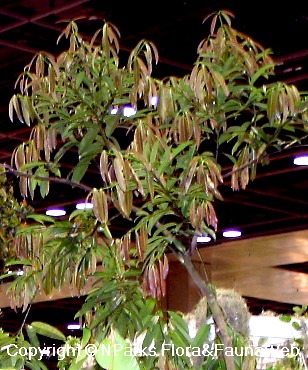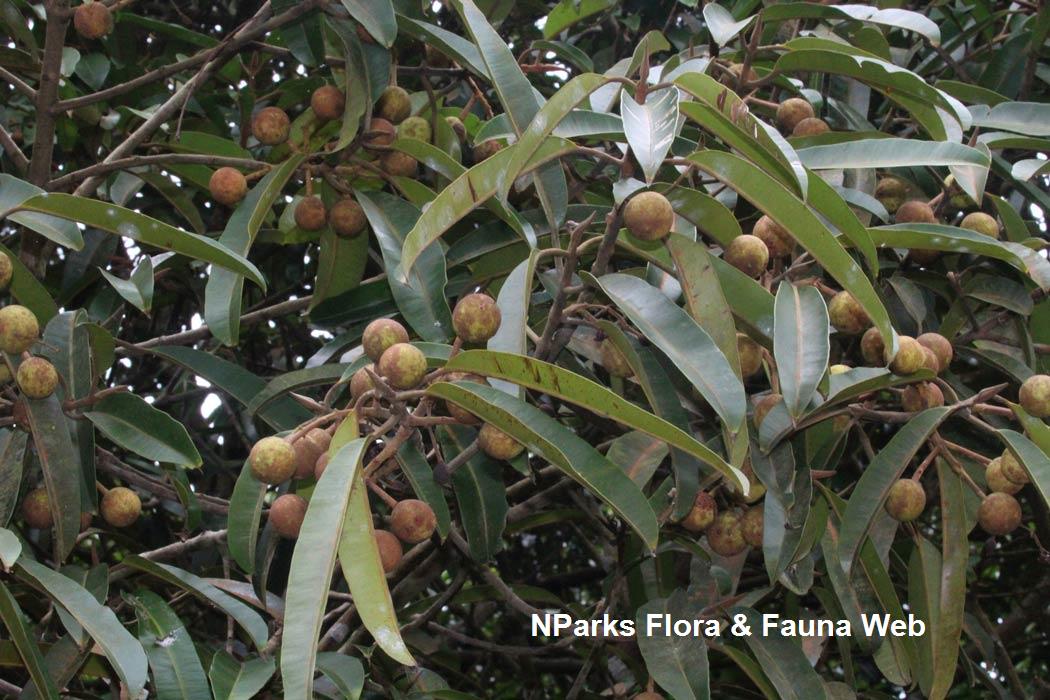_lowres.jpg)
Back
Calophyllum wallichianum var. incrassatum (M.R.Hend. & Wyatt-Sm.) P.F.Stevens
| Family Name: | Calophyllaceae |
| Synonyms: | Calophyllum incrassatum Henderson & Wyatt-Smith |
Name
Classifications and Characteristics
| Plant Division | Angiosperms (Flowering Seed Plants) (Dicotyledon) |
|---|---|
| Plant Growth Form | Tree |
| Lifespan (in Singapore) | Perennial |
| Mode of Nutrition | Autotrophic |
| Plant Shape | Broad / Mushroom / Hemispherical |
| Maximum Height | 36 m |
Biogeography
| Native Distribution | Sumatra and adjacent islands, eastern Malaysia to Borneo (including Singapore), and Sulawesi |
|---|---|
| Native Habitat | Terrestrial (Primary Rainforest, Secondary Rainforest, Monsoon Forest, Freshwater Swamp Forest) |
| Preferred Climate Zone | Tropical |
| Local Conservation Status | Native to Singapore (Vulnerable (VU)) |
Description and Ethnobotany
| Growth Form | It is a tree up to 36 m tall, with slightly curved buds at the end of the twigs. |
|---|---|
| Foliage | Its opposite, long-stalked leaves possess leathery leaf blades that are oblong to rather egg-shaped, and up to 27 by 7 cm, with a raised midrib above. |
| Flowers | Its unbranched flowering shoots are axillary, up to 4 cm long, with each bearing 7–19 fragrant flowers. |
| Fruit | Its fruits are oblong-round to oval, and up to 3 cm long, with a very small beak. Its pale green fruits turn reddish-brown when injured. Its pale brown seeds are broadly oval to rather round, 13–23 by 12–19 mm, and faintly wrinkled when dried. |
| Habitat | It grows in well-drained lowland primary rainforest, and sometimes freshwater swamp forest, or mossy heath forests, up to 1,220 m altitude. |
| Associated Fauna | Its flowers are insect-pollinated. |
| Cultivation | It can be propagated by seed. |
| Etymology | Greek kalos, beautiful; Greek phyllon, a leaf, referring to the plant’s beautifully-veined leaf blades; wallichianum, after the Danish botanist and surgeon, Nathaniel Wallich (1786–1854), originally Nathan Wolff, who contributed immensely to the knowledge of India’s flora; Latin incrassatus, thickened, referring to the thickened fruit stalk |
Landscaping Features
| Landscaping | It is suitable for streetscapes, parks and gardens. |
|---|---|
| Desirable Plant Features | Ornamental Flowers, Ornamental Foliage, Ornamental Form, Fragrant |
| Landscape Uses | General, Suitable for Roadsides, Parks & Gardens, Small Gardens |
Fauna, Pollination and Dispersal
| Fauna Pollination Dispersal Associated Fauna | Bird-Attracting (Fruits) |
|---|---|
| Pollination Method(s) | Biotic (Fauna) |
| Seed or Spore Dispersal | Biotic (Fauna) |
Plant Care and Propagation
| Light Preference | Full Sun |
|---|---|
| Water Preference | Lots of Water, Moderate Water |
| Plant Growth Rate | Moderate |
| Rootzone Tolerance | Moist Soils, Waterlogged Soils (Drains Site), Well-Drained Soils |
| Propagation Method | Seed |
Foliar
| Foliage Retention | Evergreen |
|---|---|
| Mature Foliage Colour(s) | Green |
| Mature Foliage Texture(s) | Leathery |
| Prominent Young Flush Colour(s) | Pink |
| Young Flush Texture(s) | Glossy / Shiny |
| Foliar Type | Simple / Unifoliate |
| Foliar Arrangement Along Stem | Opposite |
| Foliar Attachment to Stem | Petiolate |
| Foliar Shape(s) | Non-Palm Foliage (Ovate, Oblong) |
| Foliar Venation | Pinnate / Net |
| Foliar Margin | Entire |
Floral (Angiosperm)
| Flower & Plant Sexuality | Bisexual Flowers |
| Flower Colour(s) | White |
|---|---|
| Flower Grouping | Cluster / Inflorescence |
| Flower Location | Axillary |
| Flower Symmetry | Radial |
Fruit, Seed and Spore
| Mature Fruit Colour(s) | Green - Light Green |
|---|---|
| Fruit Classification | Simple Fruit |
| Fruit Type | Fleshy Fruit , Non-Accessory Fruit |
Image Repository
Others
| Master ID | 31171 |
|---|---|
| Species ID | 5565 |
| Flora Disclaimer | The information in this website has been compiled from reliable sources, such as reference works on medicinal plants. It is not a substitute for medical advice or treatment and NParks does not purport to provide any medical advice. Readers should always consult his/her physician before using or consuming a plant for medicinal purposes. |

.jpg)
.jpg)
_lowres.jpg)
_lowres.jpg)
_lowres.jpg)
_lowres.jpg)

_lowres.jpg)
